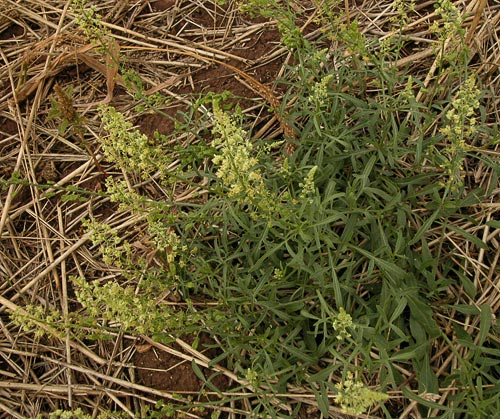Weeds
Reseda lutea Linnaeus - Wild Mignonette, Cutleaf Mignonette, Yellow Mignonette, Yellow Cut-leaved Mignonette
Systematic position.
Family Resedaceae, genus Reseda L.Biological group.
Biennial or perennial weed.Morphology and biology.
Plant 30 to 85 cm in height with erect, rough branchy stalks. Leaves 3-5-pinnate (lower ones sometimes integral); lobes of a sheet integral or 2-3-pinnate, elongate-lanceolate or linear; median lobe of the lower leaves often rounded-lyriform. Flowers zygomorphous, yellow, aggregated in apical simple multifloral racemose inflorescences, compact at flowering, later lengthening to 20 cm long. Six petals; each one expanding in a lamellar webby appendage below, being trifid at top, chartreuse; the upper petals larger. 10-24 stamens; their filaments extending upward. Subpistillate disk unilateral. Fruitlets accrete, forming unilocular ovary. Boll oblong, triquetrous, open above, with short point denticles. Seeds small, rounded, bent-reniform, smooth, shining black-brown, with projecting rootlet. Unripe seeds chartreuse and dark green. The seed with a small matte spot at base, 0.7-1.7 mm in length and about 0.5 mm in width. Blossoms in June - August. Fruits in August. Seeds sprout from depth of no more than 4 cm at temperature +2 to +34°C (optimum +12 . 20). Fruitfulness of one plant is 400,000 seeds which remain viable for 5 years.Distribution.
Baltic States, southwest Poland, Germany, Austria, Hungary, Balkan States, Asia Minor, North Africa; North America (adventive). In the territory of the former USSR, the plant is found in the middle strip and in the south of the European part, in the Caucasus and Central Asia.Ecology.
Plants grow in dry steppes having enclosed grass cover, on open clay and rubbly slopes, on limestones and chalk outcrops, along roads, on waste grounds, in garbage places, in crops and kitchen gardens.Economic significance.
The Wild Mignonette is recorded in crops of spring cereals and also of winter rye and winter wheat, being common in tilled and vegetable crops, in vineyards. Control measures include stubbling, autumn plowing, presowing soil treatment, use of fallows, herbicide treatments if necessary.Reference citations:
Artokhin K.S. 2004. Atlas of weed plants. Rostov-na-Donu: Kniga, 144 p. (in Russian).Gubanov I.A., Kiseleva K.V., Novikov V.S., Tikhomirov V.N. 2003. The illustrated keys to plants of Middle Russia. V. 2, Moscow: KMK, 665 p. (in Russian).
Keller B.A., ed. 1934. Weed plants of the USSR. V. 3. Leningrad: AN SSSR. 448 p. (in Russian).


